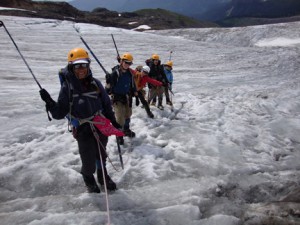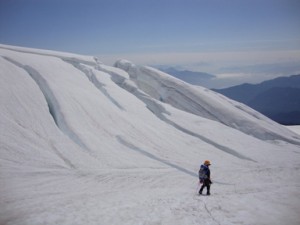Girls on Ice comes to Alaska
February 10, 2012
907-474-7468
2/10/2012
After more than a decade on the glaciers of Washington, Girls on Ice is coming to Alaska.
Girls on Ice is a program in which nine girls spend 11 adventurous days on a glacier with professional women glaciologists and mountaineers. The program is the creation of Alaska glaciologist Erin Pettit, who dreamt up the program not long after she helped lead field trips for inner-city elementary schoolers in Los Angeles.
“They made me realize the impact even a short day hike can have on kids, especially those that haven’t had that opportunity with their families,” Pettit said.

In the summer of 1999, with help from the University of Washington where she was a graduate student, Pettit organized a trip to Washington’s South Cascade Glacier. The program was open to both boys and girls, but five girls were the only ones who signed up. Pettit and her trip co-leader noticed how well the girls interacted in the group and decided to try a girl’s-only group. She chose high schoolers because middle-schoolers seemed too young for some of the required hiking, and she wanted to involve girls who were starting to think about their future careers.
Since that start in 1999, Pettit has camped on and explored South Cascade Glacier and Washington’s Mount Baker for many summers with a group of nine girls. Participants who are diverse “geographically, economically and culturally . . . over the years I think I’ve had one of (every type of girl),” she said.
Annie Bartholomew, 21, is a graduate of the program who credits her 2009 experience on Mount Baker as the reason she is now pursuing the study of glaciers and sea ice at the University of Alaska. Bartholomew, who grew up in Juneau, was an intern for Lisa Murkowski in Washington, D.C., when she learned she had been chosen for the program. After flying direct from Washington D.C. to Seattle in summer of 2009, Bartholomew found soon herself in plastic mountaineering boots lugging a 40-pound pack up Mount Baker, a 10,781-foot volcano. During the next 11 days of studying a glacier on the mountain, camping with a group of girls from all over the country and climbing to the top of the mountain, she decided she wanted to combine her love for writing and doing science in exciting places.
“After working at Murkowski’s office I thought I wanted to go to law school, but after doing Girls on Ice I learned there was so much more to discover, and the need for someone to communicate science to the public,” she said. “It was such a life-changing experience for me.”
“They’ll do amazing things if you treat them like adults, trust them and respect them,” Pettit said of her students, which now number more than 90 (many of whom still correspond with Pettit via Facebook). “You can go a long way with teenagers if you expect them to succeed. When you do, they have high expectations of themselves.”
Pettit and the other instructors of Girls on Ice teach girls how to live safely on ice, roping up to explore areas that accumulate snow and other places where ice disappears. The girls do equations and figure out the health of a glacier just like professional glaciologists. Because none of the girls have experienced life on a glacier before, they all enter a new world for two weeks.

“I’d never even backpacked before,” Bartholomew said. “And we taped up our feet beforehand with duct tape (to prevent blisters). That was a crazy experience.”
Pettit has withstood the pressures of academia to keep her program alive. She studies glaciers in Antarctica, Alaska and Greenland and also teaches at the University of Alaska Fairbanks. She chose UAF because her supervisors give her the flexibility to get on the ice with students each summer. “UAF has been fabulous with that,” she said.
This summer, for the first time, Pettit has included Alaska in her Girls on Ice plan. She enlisted three Geophysical Institute graduate students Joanna Young, Marijke Habermann and Barbara Truessel, who are organizing the Alaska version of Girls on Ice. They are still deciding on the perfect Alaska glacier to host themselves and nine girls; they prefer a small one, where the girls can move to different areas and make measurements.
“I’m a little jealous I won’t get to go, but it would be fun to be a fly on the tent as they teach it,” said Pettit, who will again be on Mount Baker this summer for the Washington version of Girls on Ice.
Pettit and her co-instructors are now gathering applications from which they will choose nine girls each for both the Washington and Alaska glacier trips. For the Alaska version, Pettit said they would choose mostly girls from Alaska, but also some from the Pacific Northwest. March 1 is the deadline for applications, which can be found at http://girlsonice.org/.
This column is provided as a public service by the Geophysical Institute at the University of Alaska Fairbanks, in cooperation with the UAF research community.


